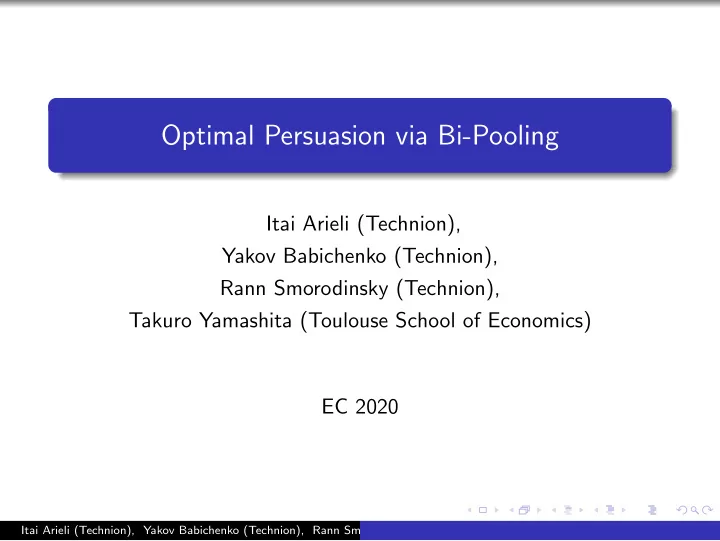

Optimal Persuasion via Bi-Pooling Itai Arieli (Technion), Yakov Babichenko (Technion), Rann Smorodinsky (Technion), Takuro Yamashita (Toulouse School of Economics) EC 2020 Itai Arieli (Technion), Yakov Babichenko (Technion), Rann Smorodinsky (Technion), Takuro Yamashita (Toulouse School of Economics)
The Partially Informed Sender Setting States: Θ = { 0 , 1 } . Sender is partially informed about the state. Namely Sender’s belief about the state is distributed according to F ∈ ∆([0 , 1]). Sender’s policy: A mapping from beliefs to signals. Receiver receives the signal, updates his belief, and takes an action that affects Sender’s utility. Bayesian persuasion: Sender commits to a policy before she observes her signal. Itai Arieli (Technion), Yakov Babichenko (Technion), Rann Smorodinsky (Technion), Takuro Yamashita (Toulouse School of Economics)
Mean Preserving Contractions Special Property: Receiver’s action is a function of posteriors’ mean. Signalling policy � Distribution over posterior means. Which distributions over posterior means are implementable? [Gentzkow, Kamenica ’16], [Kolotilin ’18] A distribution over posterior means G ∈ ∆([0 , 1]) is implementable by some signalling policy ⇔ G is a mean preserving contraction of the prior F ∈ ∆([0 , 1]). Itai Arieli (Technion), Yakov Babichenko (Technion), Rann Smorodinsky (Technion), Takuro Yamashita (Toulouse School of Economics)
Bi-Pooling Contractions F 0 1 G Main Theorem 1 Every persuasion problem admits an optimal solution that is a bi-pooling contraction. Main Theorem 2 For every bi-pooling contraction there exists a persuasion problem (a utility) for which this contraction is the unique optimal solution. Itai Arieli (Technion), Yakov Babichenko (Technion), Rann Smorodinsky (Technion), Takuro Yamashita (Toulouse School of Economics)
Recommend
More recommend